

|
Tools #4
Tubing and Tools
Authored by Wes Vann, last revised on September 28, 1997
PLEASE NOTE; Any of the fluid lines in your car should be checked for leaks prior to doing that high speed run down the road!! A gas leak could cause a fire, a trans line leak could trash your trans, and a brake leak could, well, you know what would happen. Check the lines after they have been under pressure.
ALSO NOTE; When shopping for hose line, be sure that the hose is designed for the type fluid and pressure that it will see!
GENERAL TERMS;
Hard lines; These are the steel tube lines.
Most of the original hard lines and the stuff that you buy at your local car parts store is just mild steel. If you look inside the standard tube, you will notice that there is a seam where the tube has been put together.
I will sometimes refer to "bundiflex" and this is the tubing that you can get at your auto parts store with the ends already flared and the fittings in place (bundiflex is just a generic name). You can buy this stuff in differing lengths and is the cheap and easy way to get a job done. The stuff bends real easy and the smaller sizes can even be bend by hand. No show quality here, but it may get you back on the road a few days faster!
There is nothing wrong with buying a bundiflex line and cutting it short to fit the exact requirements for what you need. By doing this, you only have to flare one end, and you also already have the fittings.
"Stainless Steel" hardlines are made of (you guessed it), stainless steel. This type tubing can look just fantastic when buffed out with a brillo pad. The stuff is extremely strong and requires that you use the high dollar tubing benders and quality flare tools. It's normally referred to as "seamless" due to there being hardly any seam within the body. This stuff looks good, but is real costly. If you are making the lines, I'd recommend that you experiment with a lot of the cheap line before spending the money for the stainless. I've thrown away a lot of stainless line due to it not being "just right"!
Hose lines (or flexible lines); These are the rubber tube lines.
Vacuum line is just a rubber tube and there isn't any form of woven cloth body within the tube. This type line is not intended to be under pressure and only a small amount of vacuum.
Fuel line has a woven cloth (or rayon) material within the body of the hose to prevent it from expanding under pressure. The type of rubber is such that the gasoline that you are using will not eat at it. I'm under the impression that if you run high concentrations of nitro-methane in a standard fuel line, it will destroy the line. It's for this reason that if you don't know, ask! If the guy behind the counter doesn't know, go somewhere else!
Standard brake lines have a woven material within the body of the hose to limit the expansion when you hit your brakes. There is expansion, and that is one of the reasons that steel braided hose is used for race cars.
The "steel braided" hose that most people think about has a woven stainless steel outer cover. There is also "steel braided" hose where the braiding is covered with an outer cover of rubber. As with all other types of hosing, there are different types depending on the type of fuel used. It's possible for a steel braided hose to look great on the outside, and yet the inside is being eaten out by the fluids it carries.
Tapered "pipe" fitting; When "pipe" is put together, the threads on both the male and female ends have a taper to them. It's this taper that forms the seal and some form of sealant is normally used.
An example of where you would find a pipe fitting on your Chevelle would be at the oil pressure sending unit at the end of the block. On my car, I am running Autometer electrical gauges and I also wanted to retain the idiot light. To do this, I had to remove the stock idiot sending unit, add a short pipe extension, and then a "T" fitting. All of these were stock "Edelman" pipe fittings.
Hard line "single flare";
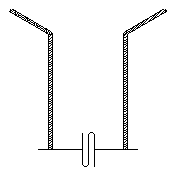
This type flare should only be used on "stainless" hardline. Due to the strength of the stainless line, a double flare isn't required and would be extremely hard to do. Note that the inside of the tubing is the sealing surface. Stainless tubing is referred to as "seamless", in that there is very little seam on the inside surface. Keep in mind the phrase "very little seam"! Due to the small amount of seam, stainless tubing can be a problem to get to seat correct. Farther down, I'll talk about brass washers that can solve this problem.
Hardline "double flare";
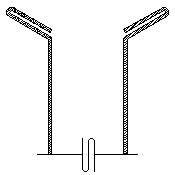
This is what you will see on most production hardline tubing. The tubing is first flared out, and then back down on itself. Note that the sealing surface is the outside of the tubing. The reason for doing a double flare is to prevent the tubing from splitting at its seam and also to have the smooth surface of the outside of the tubing become the sealing surface.
O-Ring seal;
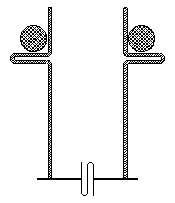
You will see this type of seal on some power steering lines and on air conditioner lines. This type of flare or crimp can't be done without costly (major money!!) tools. The tubing is crimped to create a seat for the o-ring. If you find that you have to modify this type of fitting, I recommend that you find an existing section and modify the other end.
"AN" fittings; The cool and costly fittings used on stainless braided line. The term "AN" goes back a long time and stands for Army/Navy. It has to be noted that the angle of the seal on AN fittings is not the same as the standard flare.
(as a personal note, I am not going to talk about fake AN fittings as I feel that it's just a cheap show item that kids use. Sorry if this offends anybody)
There are three basic manufactures of AN fittings, Aeroquip, Earls, and Russells (although I question if Russells really makes them).
The inside of the fitting end had a serrated edge that grabs onto the metal braiding of the hose to prevent it from pulling loose. Although the fittings are not difficult to install, you have to have a cutter that can cleanly cut the metal braid. The fitting can be removed and used over (but you trash the end of the hose).
There are various types of AN fittings available. 45 degree, 90 degree, Bango fittings, etc.
The hose (once constructed and installed) can be disconnected from what it's attached to (the carb?) with no damage to the hose or fittings.
It should be noted that standard AN fittings have no provision for rotation of the hose once installed. For that reason, it's recommended that at least one end has a "swivel seal" fitting. This is the term coined by Earls and is for a fitting that can rotate after being hooked up.
There are tons of different types of adapters for AN lines however, sometimes you have to dig to find them. (I've done my fair share of digging!!) Chances are that anything that you want to do has already been done and there is the correct adapter sitting in a box on a shelf!
TUBING CUTTERS AND BENDERS;
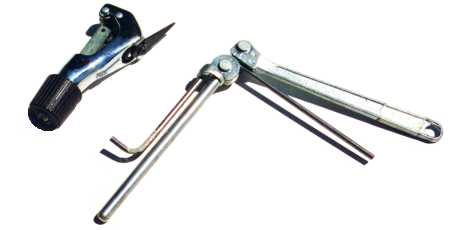
This photo shows a tubing cutter and a "high dollar" tubing bender.
A tubing cutter has a cutting bit that cuts the tube by rolling around the tube. The good part of this is that the cut is "square". The bad part is that it rolls in the end slightly. Most cutting tools also have a cutter for cleaning the inside edge.
The "high dollar" bender is the type that you will have to have in order to bend stainless tubing. They are costly (the one shown cost me about 50 bucks!) and only fit one size tubing. I've ended up buying a 3/16" for brake lines, and a 3/8" for trans and fuel lines.
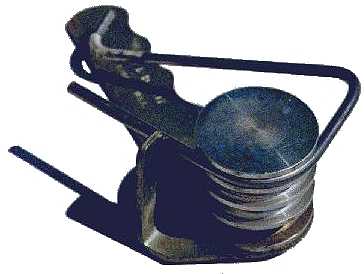
This is a photo of a "low dollar" tubing bender. With this, you can bend a variety of different size "mild steel" tubes. Don't even think about using this for stainless steel tube! You will kink the tubing and hurt your hand (BTDT).
FLARE TOOLS;
This is the tool required to flare hard lines.
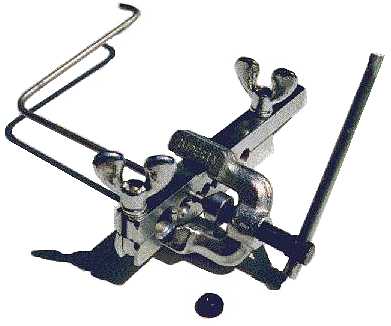
The tool is easy to use for most soft steel hard lines, and slightly harder for stainless. A quality flare tool will have serrated edges where the tool clamps the tube (to prevent it from sliding while flaring).
The tubing is clamped between the two side plates in the correct hole for that size tube. Then the clamp is installed and the cone wedge screwed down.
When doing a double flare, the little round adapter is first crimped down on the end of the tubing. Then it's removed and the flare cone screwed down again, making the double flare.
Flare-Nut wrench;
I promise that I'll get a photo here!
Not a "box" wrench, not an "open end" wrench, a "flare-nut" wrench is one of those wrenches that go almost full circle around the nut. The opening is only large enough that it can be fit over the tubing.
If you are doing brake lines, you have to use a flare nut wrench or you risk rounding off the nut! They can be gotten at Sears, so there is no reason for not having one (or several). Buy them a week before starting the job, just so that you know you have them and are not tempted to do the work without them!
Leaks;
Due to their being several postings by people who have leaks at fittings when installing stainless steel hard lines, I'm adding this new section. It's totally a "been there, done that" subject. I did most of the hard lines on my 64 wagon in stainless. This includes the bending and flaring of the fittings. I ended up with a fair amount of leaks that were well beyond what I would contribute to poor workmanship (heck, I did it). After swallowing my pride, I talked to the owner of the hose supply shop that I buy stuff from. It ends up that it's not that uncommon, even with the pros and their major high dollar tools!
The problem is that stainless steel tubing is NOT seamless. Don't believe me? Just look inside and you will see the seam! It's small, but it's there.
When flaring stainless tubing, you only do a "single" flare. (as far as I know, it's not possible to do a double flare with stainless) As a result, what was the inside of the tubing becomes the sealing surface and that little seam can cause problems.
Here is the trick; You can get soft brass, cone shaped washers. These will conform to the non-perfect shape on the end of the stainless tubing flare. They go between the item the hose is connecting to and the hose. They come in several sizes however it always seemed that I ended up having to sand down the diameter in order to fit correctly. Maybe somebody has a larger selection of sizes. I wouldn't recommend that you reuse the washers a second time due to their having already deformed.
I order to locate the washers, I recommend that you find the shop in town that rebuilds hoses for things like fork lifts. If you live in a farm town, try places that service tractors.
The simple fact is that I don't know who the manufacturer is or if they will send you just a couple. A minimum order of 500 would sure last a life time! If anybody knows of a supplier that will deal in small quanities, please let me know and I'll post them as a source!